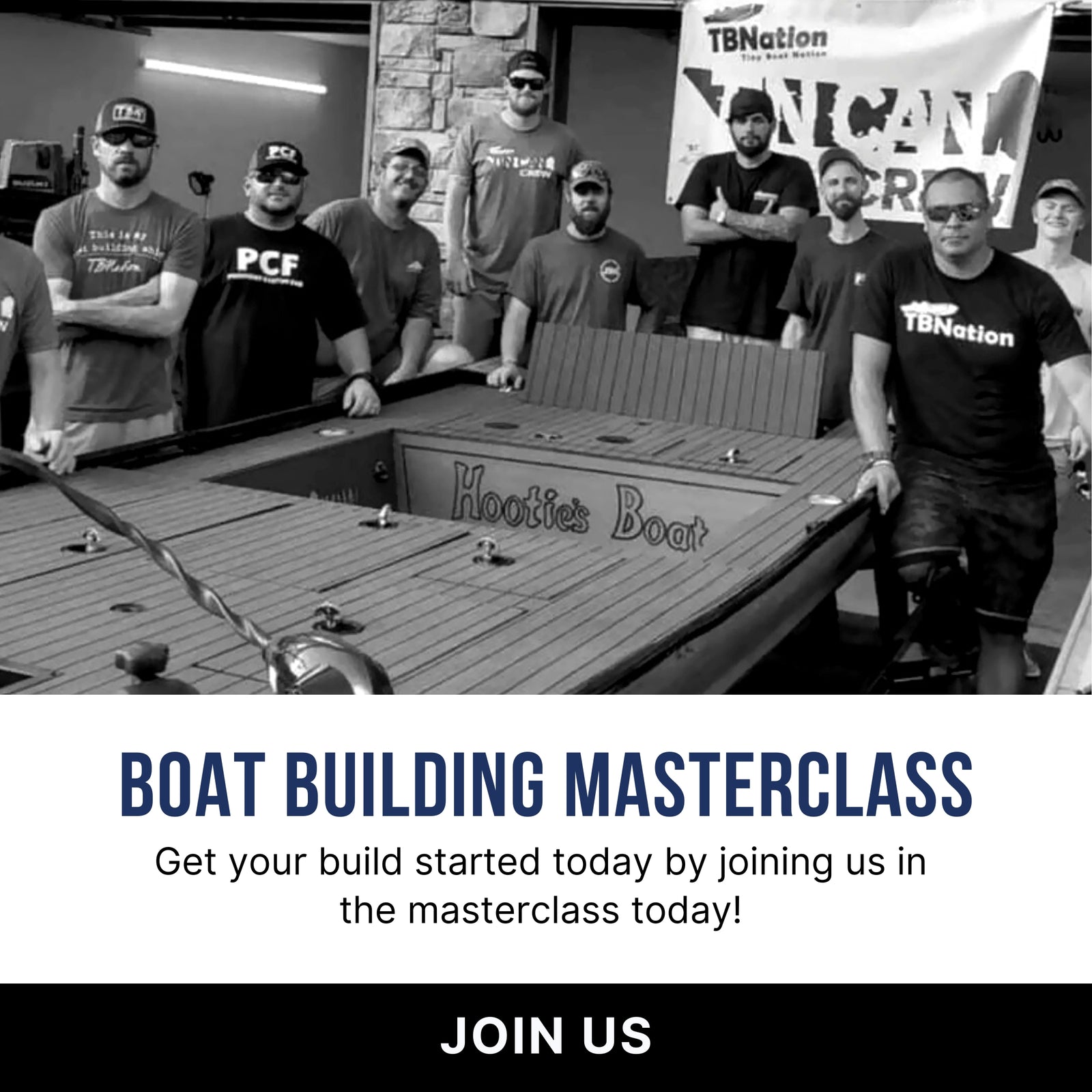Your Cart is Empty

Pond Prowler 10 Transformation: Turn Your Plastic Boat into the Ultimate Fishing Rig
Key Takeaways
-
The Pond Prowler 10 is a popular, affordable plastic boat ideal for anglers seeking a lightweight and customizable fishing platform.
-
With smart Pond Prowler modifications like adding an aluminum frame, decking, and safe wiring, this plastic jon boat can be transformed into a stable, fully rigged plastic bass boat.
-
Proper planning of gear placement and weight distribution is essential to maximize performance and keep the boat within its 515-pound weight limit.
-
Essential Pond Prowler accessories such as trolling motors, rod holders, pedestal seats, and storage compartments significantly enhance fishing efficiency and comfort.
-
Resources like Tiny Boat Nation provide DIY kits, tutorials, and community support, helping anglers build reliable and professional-quality rigs without hassle.
The Pond Prowler 10 is one of the most popular entry-level plastic boats available, especially for anglers who want a budget-friendly and portable solution. While this boat may seem basic right out of the box, with the right upgrades, it can be transformed into a fully rigged fishing machine. This guide will walk you through everything you need to know about modifying your Pond Prowler, from decking and wiring to essential accessories and community-supported upgrades.
If you're looking to turn your compact boat into a serious small-water angling platform, this article will show you exactly how. With thoughtful modifications, your Pond Prowler 10 can compete with more expensive rigs and provide excellent performance on lakes, ponds, and calm rivers.
Why the Pond Prowler 10 is a Great Starting Point
The Pond Prowler 10 is a two-person, twin-hull plastic jon boat designed for lakes, ponds, and calm backwaters. At just 10 feet long and around 100 pounds, it's lightweight, affordable, and easy to transport. Its design makes it ideal for anglers who want a no-hassle solution they can customize to fit their fishing style. Out of the box, the boat includes two swivel seats, molded footwells, and a motor mount, but it lacks features like a stable casting deck, rod storage, and electrical wiring. That’s where pond prowler modifications come in.
What makes this plastic boat special is its versatility. With its sturdy hull and flat-bottom layout, you can modify it much like a plastic bass boat, adding decks, electronics, lights, and storage. The fact that it floats high, handles shallow water well, and is compatible with electric motors makes it a popular choice for DIY builds.
Planning Your Pond Prowler Modifications
Identify Your Essential Gear
Begin by making a checklist of the gear and equipment you use regularly. This could include a trolling motor, fish finder, rod holders, battery box, tackle storage, and seating upgrades. Determine which items are critical for every trip and which ones are optional. Then decide where each piece of gear will be placed to ensure it’s both functional and doesn’t interfere with movement or casting. Keeping your most-used items within arm’s reach will improve your overall fishing experience.
Optimize Battery and Electronics Placement
Proper battery placement is crucial for maintaining balance and safety. The ideal location is usually in the center of the boat, close to the floor, to lower the center of gravity and improve stability. Your electronics, such as switch panels, sonar units, and USB ports, should be installed in accessible but protected areas. Avoid placing wiring near areas that might get wet or stepped on. Grouping your electronics in a control panel setup can make them easier to manage and troubleshoot later.
Understand the Weight Limit
The Pond Prowler 10 has a maximum weight capacity of 515 pounds, which includes passengers, equipment, and any modifications. If you fish solo, you’ll have more flexibility with your materials and gear; with two people, you’ll need to be more weight-conscious. Avoid using heavy plywood or dense framing materials that can quickly eat into your weight budget. Consider lighter alternatives like composite boards, aluminum framing, or foam-filled support structures. Prioritizing lightweight materials ensures the boat remains safe, buoyant, and responsive on the water.
Sketch Your Layout Before Building
Before you pick up any tools or materials, sketch out your entire build on paper or using digital design software. A simple top-down diagram helps you visualize where everything will go and whether you have enough space for it. Planning your layout in advance reduces trial-and-error mistakes, especially when cutting deck pieces or routing wires. It also lets you spot issues like poor weight distribution or limited access to storage. Once you're confident in the layout, you can begin construction with a clear, organized plan.
How to Reinforce and Deck Out Your Plastic Boat
-
Build a Strong Internal Frame- The flexible hull of the Pond Prowler 10 needs reinforcement to handle added weight and deck pressure. Many DIY builders use aluminum square tubing to create a lightweight, rust-resistant frame inside the boat. This frame supports the deck and prevents the plastic from warping or sagging. It also distributes weight evenly across the hull.
-
Add Foam Support and Buoyancy - Closed-cell foam blocks are commonly added beneath the deck to prevent flex and improve flotation. The foam supports the deck from below and adds a layer of safety in case of flooding. It also helps your boat feel more solid and reduces noise when moving around. Be sure to leave space for wiring and access.
-
Install the Decking Surface -Marine-grade plywood or composite board is cut to fit over the frame, creating a sturdy surface for your deck. Composite options are lighter and more water-resistant but often cost more. Make sure to seal all wood surfaces with waterproof paint or epoxy to prevent rot. Test the layout before securing panels permanently.
-
Use EVA Foam for Grip and Comfort- Instead of heavy carpet, EVA foam is a smart choice for deck covering. It’s lightweight, waterproof, and provides excellent traction, even when wet. EVA also adds comfort for long hours of standing or kneeling. Apply it with marine adhesive for a clean, durable finish.
-
Include Access Hatches for Storage- Access hatches are crucial for reaching the gear stored under your deck, like batteries and wiring. You can use pre-made hatch kits or custom-build your own with plywood and hinges. Keep the layout organized to make maintenance easier. Proper access helps avoid tearing into your deck later.
-
Enjoy a Stable, Elevated Platform -With a full deck and reinforcement, your Pond Prowler 10 becomes far more stable and functional. It allows you to stand comfortably and move around while fishing. The boat will feel more like a purpose-built plastic bass boat than an entry-level fishing craft. This upgrade greatly improves both performance and confidence on the water.
How to Install Electronics and Wiring in a Pond Prowler 10
Choose the Right Marine Battery
Start by selecting a deep cycle marine battery that can handle the power requirements of your trolling motor and other electronics. Group 24 or 27 batteries are popular choices for small boats like the Pond Prowler due to their balance of size and capacity. Make sure the battery has enough amp hours to last through your typical fishing trips.
Using a dedicated battery box is essential to keep it secure and protect it from water. Additionally, consider battery type, lead-acid is common and affordable, while lithium options are lighter and longer-lasting but more expensive.
Install a Waterproof Switch Panel
A waterproof switch panel with built-in breakers or fuses is critical for safely controlling your boat’s electronics. It centralizes the power management for lights, bilge pumps, fish finders, and other accessories. Place the panel in a dry, easily accessible location, preferably near your seat or main operating area. Labeling each switch helps prevent confusion during use and maintenance. Investing in a quality panel also reduces the risk of electrical shorts or failures.
Use Marine-Grade Wiring and Connectors
Marine-grade wiring and connectors are designed to resist corrosion from water and salt, making them essential for any boat electrical system. Heat-shrink connectors provide a waterproof seal that protects connections from moisture and oxidation. Running wires inside protective conduit or cable sleeves prevents abrasion and damage from moving parts or storage gear. Secure all wiring with clips or zip ties to keep them tidy and out of the way. Regularly inspect your wiring to catch any wear or damage early.
Route Wiring with Care
Careful planning of wire routes prevents damage and electrical interference. Avoid running power cables close to sensitive electronics like your fish finder transducer cables to reduce signal noise. Group wires by function to make future troubleshooting or upgrades easier. Leave some slack in your wiring to accommodate component repositioning without needing to rewire. Use cable ties and adhesive mounts to keep wires organized and out of foot traffic or gear areas.
Mount and Secure the Battery Safely
Positioning your battery low and centered in the boat improves balance and stability. Use a sturdy battery box or tray with secure straps to prevent movement during rough water or transport. Ensure the battery is well ventilated to avoid overheating. Adding an onboard charger is a convenient upgrade, allowing you to recharge your battery between trips without removing it. If weight is a concern, lithium batteries offer significant weight savings but at a higher upfront cost.
Add Key Electronic Accessories
Popular pond prowler accessories include LED navigation lights that improve visibility and safety during low-light conditions. Deck lighting is invaluable for early morning or night fishing, providing ample illumination without draining too much power. USB charging ports allow you to keep phones, cameras, or other devices powered while on the water.
A reliable fish finder with a properly mounted display and transducer will greatly increase your catch rate. Don’t forget a bilge pump to keep your boat dry during unexpected water ingress.
Pond Prowler Accessories That Maximize Utility
There are plenty of aftermarket Pond Prowler accessories designed to boost your comfort and fishing efficiency on the water. Popular upgrades include pedestal seat bases that raise your seating height for better casting, vertical rod holders to keep your gear organized and within reach, and anchor systems for easy positioning in shallow water.
Additional enhancements like under-deck storage compartments help keep your gear secure and clutter-free. Modular rail systems are also a favorite, allowing you to mount tools, cup holders, or action cameras wherever you need them. Cleats for tying off and shallow water anchor mounts add further convenience for various fishing scenarios.
For anglers using their plastic boat on electric-only lakes, a trolling motor is almost essential. Many Pond Prowler 10 owners choose models with 30–55 pounds of thrust—powerful enough to maneuver quietly without sacrificing stability. When installing any accessories that attach to the hull, always use proper backing plates inside the boat. Because the hull is molded plastic, spreading the load over a larger area helps prevent stress cracks and keeps your boat durable for years to come.
Transforming the Palm Prowler 10 – From Cheap Plastic to Custom Fishing Rig
Step 1: Stripping Down the Palm Prowler

The build began with the Palm Prowler 10 from Bass Pro Shops. While the smaller 8-foot model is easier to modify, the 10-foot version offers more deck space and load capacity, making it ideal for customization. The first step involved removing all internal styrofoam blocks. Although these blocks provided flotation, they often caused waterlogging over time. Once removed, the hull required additional internal support to restore structural integrity.
Step 2: Reinforcing the Structure

To strengthen the boat, an internal aluminum skeleton was installed, with sections of foam reintroduced for buoyancy. Working with plastic and aluminum presented challenges due to poor bonding and heat sensitivity. After extensive adjustments, a welded aluminum subfloor was added to eliminate flex and creaking. Despite concerns about heat damage, the hull remained intact throughout the welding process, maintaining a clean, solid foundation.
Step 3: Adding Side Rails and Custom Anchors

Protective side rails were added to prevent gear from sliding overboard and to create a sleek, skiff-like appearance. Because small boats are easily affected by wind, an anchor system was essential. Mounting a standard anchor setup to thin plastic was not an option, so a custom aluminum anchor chassis was fabricated and integrated into the internal frame.
A pin-actuated anchor system was designed using aluminum tubing, RC-grade springs, and UHMW bushings, providing reliable performance and smooth operation.
Step 4: Front Deck Modifications

The bow area was redesigned to improve fishing functionality. Dual fish finder mounts, a recessed foot pedal tray, and a custom Livescope turret were added. Instead of using a heavy trolling motor, a lightweight Minn Kota Edge was paired with a cable-driven turret adapted from a kayak rudder system. This setup offered precise control and smooth movement without compromising balance or weight distribution.
Step 5: Building the Dual Rod Lockers

A key design feature included dual rod lockers integrated into the catamaran-style hulls. Insulated walls were built using pink foam board and reinforced with aluminum framing and rivet washers for durability. Each side featured four bilge pumps, two automatic and two manual, along with dual drain ports. These additions increased safety, ensuring the boat remained buoyant even when fully loaded.
Step 6: Decking and Soundproofing

After the main structure was secured, foam was poured to support the rod tubes, followed by the installation of aluminum deck panels. To reduce vibration and noise, pink foam board was used as an underlayment. Although the added materials increased overall weight, they also improved stability and provided a sturdy deck surface ideal for standing and casting.
Step 7: Custom EVA Foam Deck

The top deck was finished with hand-cut HydroTurf EVA foam, commonly used in high-end bass boats. Using simple tools such as routers, contour bits, and low-temperature soldering irons, the foam was shaped for a professional, textured finish. HydroTurf’s self-routing sheets made the process efficient while keeping the cost affordable, resulting in a clean, durable, and slip-resistant surface.
Step 8: Wiring, Outfitting, and Final Touches

The final phase included electrical and accessory installations. Custom aluminum hatches, drop-in liners, and lithium batteries were added along with cutoff switches and corner caddies for organization. Every element was hand-fitted and reinforced with precision hardware to ensure reliability and long-term durability.
Step 9: Testing on the Water

During testing, the Palm Prowler 10 proved stable, maneuverable, and efficient. The flat deck design provided a comfortable fishing platform, while the custom anchor system and Livescope turret functioned smoothly. Despite initial skepticism about the plastic hull, the finished boat delivered excellent performance on the water.
The Tiny Boat Nation Advantage
If you want to fast-track your build, Tiny Boat Nation is a top resource for DIY fishing boat conversions. They offer custom kits specifically designed for plastic boats like the Pond Prowler 10. These kits often include pre-cut deck panels, aluminum framing, and wiring harnesses, saving you time and mistakes during your build.
The Tiny Boat Nation community also shares tutorials, ideas, and full walkthroughs on YouTube and forums. This support network is invaluable, especially for first-time builders. It’s also a great way to find inspiration and avoid common pitfalls. Their store includes everything from seat mounts to switch panels and carpet, so you don’t have to search all over the internet for parts.
Real-World Performance After Modification

-
Improved Stability and Handling -After all the modifications, the Pond Prowler 10 feels much more stable and solid on the water. The reinforced frame and decking reduce flex, giving you confidence when standing or moving around. It handles well with a trolling motor, allowing quiet navigation through shallow and tight fishing spots.
-
Efficient Storage and Comfort-With organized storage compartments and well-chosen accessories, you can keep your gear neatly arranged and accessible. This makes fishing trips more efficient and comfortable, letting you focus on catching fish rather than managing clutter. Longer outings become easier with a thoughtfully modified setup.
-
Comparable to More Expensive Boats -Many owners report their upgraded Pond Prowler 10 performs on par with commercial aluminum jon boats or even kayaks in a similar price range. While it won’t match the rough-water capability of fiberglass hulls, a balanced plastic bass boat handles most freshwater fishing situations with ease. It’s a versatile and budget-friendly option for anglers who want a dependable rig.
Common Pitfalls to Avoid
Proper Storage to Prevent Warping
Plastic boats like the Pond Prowler 10 can warp if stored improperly or overloaded. Always keep your boat on a flat surface or trailer to maintain its shape. Avoid leaving it exposed to direct sunlight for extended periods without a protective cover, as UV rays can weaken and degrade the plastic over time.
Avoid Excessive Drilling Without Support
Drilling too many holes in unsupported areas of the hull can lead to cracks and structural damage over time. To maintain the boat’s integrity, use backing plates or aluminum brackets when mounting accessories. This helps spread out the load and reduces stress on the plastic.
Maintain Proper Weight Balance
Balancing your load is essential for optimal handling and safety. Too much weight at the stern can cause poor tracking and increase the risk of water intrusion. Always test your boat’s setup in shallow water before heading out on longer trips to ensure stability and performance.
Final Thoughts
Transforming a Pond Prowler 10 from a simple plastic boat into a fully outfitted fishing rig is one of the most rewarding DIY projects an angler can take on. With thoughtful planning, structural upgrades, smart wiring, and a few must-have accessories, you can create a custom fishing platform that rivals much more expensive options.
Whether you’re a weekend warrior or a daily bass chaser, building your own pond prowler modifications is a great way to save money, learn boat rigging, and end up with a unique fishing rig tailored exactly to your needs. Supported by communities like Tiny Boat Nation and a growing ecosystem of accessories, the Pond Prowler 10 continues to prove that even a plastic jon boat can become a serious tool in the hands of a dedicated angler.
Frequently Asked Questions
1: What makes the Pond Prowler 10 a good starter plastic boat for fishing?
The Pond Prowler 10 is lightweight, durable, and easy to transport. Its flat-bottom hull is perfect for shallow waters, and it’s designed to be modified with various accessories, making it an excellent entry-level plastic jon boat.
2: How can I reinforce my Pond Prowler 10 for better stability?
Most builders install an internal aluminum frame and add marine-grade decking with EVA foam covering. These modifications strengthen the hull and create a stable casting deck, turning your plastic boat into a more solid fishing rig.
3: What are must-have Pond Prowler accessories for fishing?
Key accessories include a trolling motor (30–55 lb thrust), vertical rod holders, pedestal seats, LED navigation lights, and under-deck storage. These additions improve boat handling, organization, and comfort.
4: How does Tiny Boat Nation help with Pond Prowler 10 modifications?
Tiny Boat Nation offers custom kits that include pre-cut decks, frames, and wiring harnesses tailored for plastic boats like the Pond Prowler 10. Their community also shares build guides, tips, and product recommendations for a smoother DIY experience.
5: What common mistakes should I avoid when modifying a plastic bass boat?
Avoid overloading the boat beyond its 515-pound capacity, drilling holes without backing plates, and improper storage that causes warping. Balancing the load and securing electronics properly ensures longevity and safe operation.
Join Our VIP List
Join the Tiny Boat Nation VIP Members List.
It's Free! Stay Up To Date With Announcements, Product Give Aways, News and Promotions.










